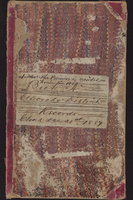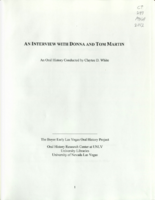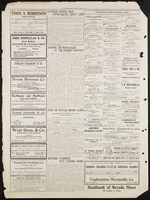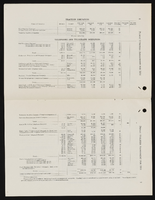Search the Special Collections and Archives Portal
Search Results

Book A of the Mining Records of El Dorado Mining District, Lincoln Co., Nevada, June 1st, 1874, closed Dec. 31, 1887
Date
Description
Text
Robert Woodruff Papers
Identifier
Abstract
The Robert Woodruff Papers (1927-2001) are comprised of materials documenting Woodruff’s career and family life in Las Vegas and Henderson, Nevada, as well as his travels around the United States and abroad. Materials include newspaper clippings, photographic prints and transparencies, personal correspondence, and publications such as Las Vegas tourist brochures and pamphlets dating from the 1930s and 1940s. Visual materials include portraits, city scenes, and landscapes throughout Nevada and the United States, as well as some photographs of international travels.
Archival Collection
Two unknown people at Walking Box Ranch, Nevada with a horse: photographic print
Date
Archival Collection
Description
Bell Family Scrapbook scanning, Set 2, proofed 08.04.2010
Image
"The Cowboy Kid:" section of a promotional document: Newspaper Clipping
Date
Archival Collection
Text
"The Cowboy Kid:" section of a promotional document: Newspaper Clipping
Date
Archival Collection
Text

Transcript of interview with Clark Crocker by Monica Lehman, March 3, 1978
Date
Archival Collection
Description
On March 3, 1978, Monica Lehman interviewed Clark Crocker (born 1920 in Westfield, Massachusetts) about his experiences while living in Nevada. Crocker first talks about his family and educational background before describing his experiences from going to school in both California and Massachusetts. Crocker then describes what he knows about the building of Hoover Dam and later talks about his career as a teacher and school principal. The two also discuss Crocker’s hobbies and volunteer work, including that for the fire department in Pahrump, and they later discuss Crocker’s experiences as both a frogman and navigator for the United States Navy during World War II. The interview concludes with some of Crocker’s thoughts and philosophies on how curriculum should be structured in schools.
Text

Transcript of interview with Tom and Donna Martin by Claytee White, January 31, 2013
Date
Archival Collection
Description
Hailing from Indiana and California, Donna Guiffre Martin and Tom Martin came to Las Vegas in the early 1950s as their parents sought new opportunities. Donna's father, Gus Guiffre, quickly established himself as a local television personality, while Tom's father took on a variety of entrepreneurial opportunities. Like many of the young people in Las Vegas, Donna and Tom enjoyed riding around town; horse-back riding; football games; Helldorado - and, of course, Rancho High School. This interview covers both Donna and Tom's early years before their moves to Las Vegas, as well as their memories of first homes, childhood experiences, early adulthood and their current lives.
Text


